How to Play Darts: A Beginner’s Guide to Darts
Home > How to Play Darts This website is reader-supported. We may earn a small fee from qualifying purchases through product links.Darts is now more popular than ever. There are huge TV events with wild crowds, massive prizes to be won, and an ever-increasing interest among amateur players.
This guide will teach you how to play darts, even if you’re a total beginner.
In this six-part guide, I’ll walk you through the basics of how to play darts. I’ll teach you how to set up a dart board, how darts scoring works, how to throw darts, and even give you some darts practice routines to help you get to grips with the movement.
On this page:
- Basic Darts Terminology
- Getting Familiar with the Dart Board
- Darts Scoring System Explained
- Setting up a Dart Board: Distances and Measurements
- Throwing Darts 101
- Darts Practice Routines
Let’s start with the very basics and teach you how to play darts like a champion.
1. Basic Darts Terminology
Darts has a seemingly endless amount of slang terms that can seem quite daunting, but we’ll be keeping things simple in these early tutorials.
Here are all the phrases and terms you need to know while learning how to play darts:
- Oche – Pronounced as “ockey”. The oche is the line from which you throw your darts. Darts players are said to be either on the oche or at the oche – either phrase works fine.
- Barrel – The barrel of a dart is the thick metal part at the front end of the dart where a dart is usually held.
- Shaft/stem – The shaft, or stem, of a dart is the part behind the barrel where the flight is mounted.
- Bust – Overscoring so that you cannot finish the match. If you score too high for you to be able to legally finish the match, your turn is null and void, and the game continues with the opponent throwing next.
2. Getting Familiar with the Dart Board
Dart boards are available in a range of materials from bristled dart boards, cork dart boards, all the way through to plastic boards. There are advantages and disadvantages to each, but the best dart boards are typically bristled dart boards manufactured using sisal.
Dart boards also have varying number setups depending on their usage, but in this beginner’s guide to darts, we’re going to be focusing on the most common: the “clock” (or “trebles”) dart board.
A dart board is like a pizza, divided into 20 equal slices (or segments), where each slice represents a different score:
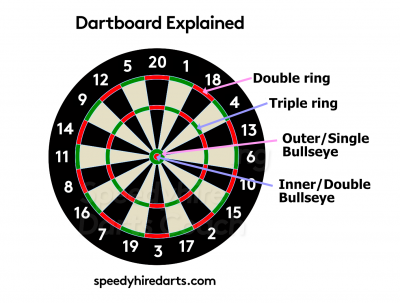
The outer ring around the dart board is the double ring, hitting here nets you double the score of the board segment you’ve hit. For example, if you hit the double ring of the topmost segment, instead of the usual 20, you’ll score 40 points.
The inner ring of the dart board, halfway between the outer ring and the bullseye, is called the treble ring. As you might have guessed, hitting here nets you treble the points for that segment.
The middle of the dart board is where you’ll find the bullseye, or bull, for short. The green outer ring of the bullseye is the single bullseye. The red circle at the very center of the board is called the double bullseye.
When darts players say the bullseye with no other content, they’re almost always referring to the inner red circle, the double bull.
3. Setting up a Dart Board: Distances and Measurements
One of the most important things to do when learning to play darts is to set up the dart board correctly.
You can spend countless hours practicing on a board that’s set up wrongly, and you’ll probably feel like you’re getting better. However, when the time comes to play on a correctly set up board, all the distances will have changed, and you’ll be back to square one.
To set up a dart board correctly, make sure the dart board is rotated so that the 20 segment is at the very top. Then, fix the dart board to the wall so that the center of the bullseye is 173cm (5ft 8in) from the ground.
To set up the oche, you should measure 293.4cm (9ft 7½in) diagonally back from the center of the bullseye to the floor.
If you set up the height and the diagonal line correctly, you should have a throwing distance (from the front of the dart board to the back of the oche) of 237cm (7ft 9¼in).
The following diagram will show you these measurements in action:
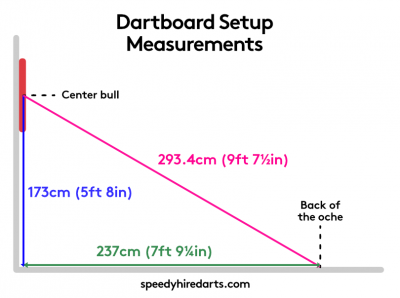
For more reading on setting up a dart board, common mistakes to avoid, and why measuring diagonally is usually better than measuring from the floor, read my guide to setting up a dart board.
4. Darts Scoring System Explained
The most common game, and the game played in most professional matches, is 501 up; it’s usually just referred to as 501.
When playing a match of 501, both players start with a score of 501. Each player throws three darts each turn, and the total score of the three darts gets deducted from their total. The goal is to be the first player to reach a score of exactly 0; however, the final dart must land in a double or the double bullseye.
If a player reaches a score of 1 or scores so that they go below 0, the turn is considered bust. When this happens, their total returns to what it was before the current turn, and the match resumes as normal, with the opposing player throwing next.
There is no need to use all three darts. If a player begins their turn with a score of 32 remaining, then a single dart in the double-16 will win the match. Cebuano language.
For shorter matches, the same ruleset applied, but the players start with a total score of 301 instead of 501. This variant is named, imaginatively, 301 up.
For a better understanding of how darts scoring works and the rules of darts, read my guide to darts scoring and darts rules. You’ll find a comprehensive guide to 501 darts and learn about other darts games you can play on a standard dart board.
5. Throwing Darts 101
The following three sections detail how to stand, how to grip a dart, and how to throw a dart. This section will teach you everything you need to find your natural dart throw.
5.1 How to Stand to Throw Darts
Step up naturally to the oche (throwing line) with your leading foot closest to the line. If you’re right-handed, your body should be facing to the left of the dart board, and vice versa for a left-hander.
Lean slightly forwards towards the dart board, placing almost all of your weight on your leading leg. Your trailing leg should be used to keep you balanced.
The angle of your leading foot does not matter as long as it doesn’t cross the throwing line. It should be in a position that feels natural to you and makes you feel balanced whilst slightly leaning forwards.
Extend your throwing arm completely outwards; fingers pointed to the board. You should adjust your position so that, when looking down your arm, your arm is pointing in a straight line towards the treble 20.
Most people struggle with lining up straight to the center of the board like this. Our vision alone does not allow us to get this right most of the time, so here’s a handy trick you can use to make sure you’re dead center.
Create an “alignment block” by drawing or taping a straight line across two items of differing heights. I sometimes use books of different thicknesses for this:
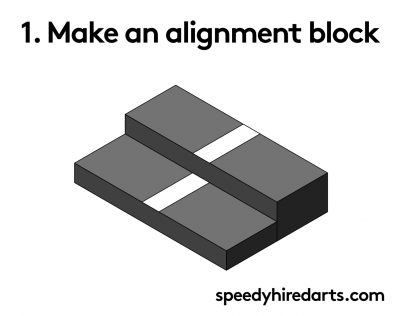
Place the block at the base of the wall directly beneath the bullseye, with the thinner part facing the wall like so:
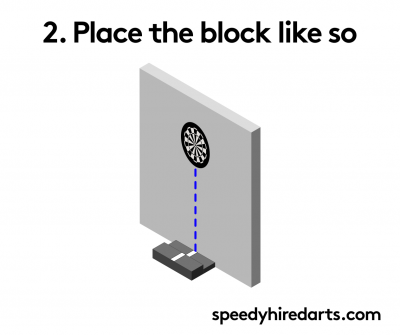
When you step back to the oche and align yourself, ready to throw, lower your sights slowly and steadily until you can see the lines. What do you see?
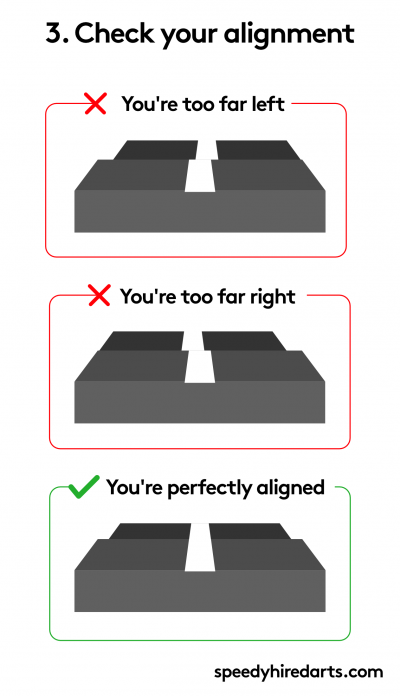
If the lines are disconnected and don’t form a straight line, then you’re off-center. Re-align until the two lines form a perfect single line.
5.2 How to Grip Darts
The only rule of gripping a dart is not to “strangle” the dart by holding it too tightly. I’ve seen countless players during my career as a coach, newcomers especially, who hold on to the dart for dear life.
A strangle grip will put stress on the dart as you throw and cause you all kinds of problems with your release. Hold the dart lightly, treat it like a feather.
Aside from gripping too tightly, there’s no right or wrong technique to grip a dart, despite what many will tell you.
To find your natural grip, just pick up a dart and repeat a throwing motion until it feels like second nature.
Some players hold the dart with two fingers, though three and four fingers are more common. I’d advise you keep your pinky out of it if you can, but if it feels more comfortable for you with it, then go ahead.
It doesn’t even really matter where you hold the dart, as long as it’s comfortable. Some players prefer to hold at the back of the barrel, others at the very front. I hold the dart in the middle of the barrel and place my ring finger on the point.
If you pick up a dart right now and can’t find a comfortable way to grip it, then my advice is just to throw a few. I assure you, you’ll start to feel more and more comfortable holding the dart, no matter the technique you adopted.
5.3 How to Throw Darts
Throwing styles differ between players, but a smooth release action and getting a full range of motion are the two things I try to teach new players.
Of all the pros, my favorite throwing technique is Gary Anderson’s, the two-time PDC World Champion. I’d recommend watching this video of Gary Anderson’s stance, grip, and throw (embedded below) to get a good idea of just how smooth his throwing action is.
Now, it’s important to remember that everyone has a different throwing style. What works for some players won’t work for others, and you can’t force a darts player to emulate someone else’s throw, even if they’re only just learning how to play darts; it just doesn’t work.
With that in mind, let’s break down Gary’s throw into three parts to see what every good darts throw has in common.
Bringing back the dart
As the image below demonstrates, Gary brings back the dart right beneath the eyeline. While the position of the dart is purely down to personal preference, what’s great about Gary’s throw is that he keeps things nice and tightly in line at the elbow and wrist.
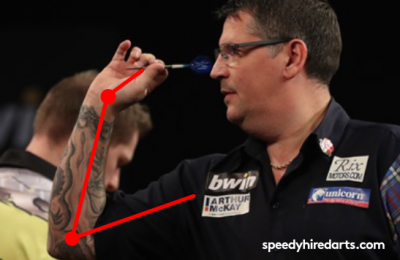
Releasing the dart
Releasing the dart is where Gary’s lining up really pays off. With the joints of the elbow and wrist perfectly lined up with his target, Gary releases the dart slightly before it reaches the peak of its flight arc.
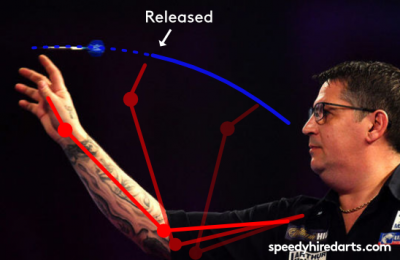
Following through
Despite most of a dart throw being unique to each player, this is the one aspect I highly recommend you try to incorporate in your throw. After releasing the dart, keep the throwing motion going all the way until your arm is perfectly straight. This following-through motion makes sure you:
- Get power behind the dart by releasing mid-throw rather than at the end of the throwing motion
- Keep a straight line while releasing because you’re not snapping away to slow your arm down
Here’s Gary, showing us all once again how it should be done:
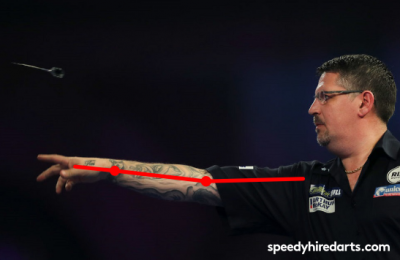
6. Dart Practice Routines
Darts, like all pressure sports, is as much about the mental aspect as it is the physical. In my career as a darts coach, I’ve seen players with all the technical ability in the world crumble under pressure and become useless.
Mindset matters.
To give yourself the best start in darts, you need to master muscle memory, learn to block out distractions, and build confidence that you will hit that double when it matters.
To do this, you need to implement effective practice darts routines. The goal is to get your mindset conditioned to ignore all doubt and fully believe that you will hit your target.
To read a list of some of my recommended darts practice routines, read my guide on how to practice darts.
Some dart practice routines suit some players better than others.
I find that playing slightly above my natural pace while executing practice routines helps me to avoid over-thinking when I play competitively. For other dart players, a constant rhythm performed repetitively, sometimes throwing up to 12 darts in one visit, helps to instill calm confidence at the oche. Everyone is different; it depends on what works for you.
Another key aspect of darts that can only be achieved through practice is counting.
Keeping a steady rhythm while learning how to play darts is easy because you’re rarely playing real matches. You can throw for the 20s, bulls, whatever.
In a game though, you’re only as fast as your counting. If you stumble over how much score you have left and what you should be aiming to hit, your game is disrupted. Once this happens it can be very difficult to get back into your rhythm.
My advice is to carefully study the board, learn the value of all the doubles and trebles, then use darts counting practice routines to make the numbers stick.
You don’t have to be good at maths to be able to count in darts, believe me, I’m hopeless at maths. It’s just a case of remembering the patterns.
Thanks for reading, I hope you found this guide useful to help you learn how to play darts.
If you’re struggling, or want to take the next step in your darts career, book a coaching session with me, or drop me an email at [email protected].